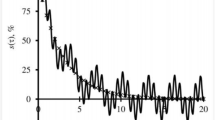Abstract
The possibility of using algorithms for predicting transients in measurement instruments is considered, in particular, in dissolved oxygen analyzers, instruments used for measuring mass concentrations in the microgram range. The objective that is set forth is to reduce the time taken to evaluate oxygen concentration during a transient from high to low concentrations. A signal processing algorithm is proposed using which it is possible to produce a new transient for obtaining current oxygen concentration values that converge to their steady values within a shorter period of time. The effectiveness of the proposed algorithm is studied taking as an example three typical sensors having significantly different response times. It is shown that for relatively slow sensors the transient in which may last for a few hundreds of seconds, an essentially shorter (by up to a factor of 2) duration of measurement procedure can be achieved.
Similar content being viewed by others
References
O. I. Lobanok and M. V. Fedoseev, “Automated chemical monitoring in new projects of nuclear power plant units,” Therm. Eng. 60(7), 472 (2013).
VR29.00.000RE: A MARK-302T Dissolved Oxygen Analyzer (Vzor, Nizhni Novgorod, 2013), http://www.vzor.nnov.ru/doc/302t-re.pdf.
S. A. Aivazyan and V. S. Mkhitaryan, Applied Statistics and Fundamentals of Econometrics: A Handbook for Higher Schools (UNITY, Moscow, 1998) [in Russian].
V. A. Kolemaev and V. N. Kalinina, Probability Theory and Mathematical Statistics: A Handbook, Ed. by V. A. Kolemaev (INFRA-M, Moscow, 1997) [in Russian].
G. S. Magdanov, “A digital predicting and differentiating device,” RF Patent No. 2450343, Izobret. Polezn. Modeli, No. 13 (2012).
G. S. Petrichenko, L. N. Dudnik, M. Yu. Srur, and D. N. Shabel’nik, “A device for predicting the technical state of systems,” RF Patent No. 2409827, Izobret. Polezn. Modeli, No. 2 (2011).
A. E. Shelest, Microcalculators in Physics (Nauka, Moscow, 1988) [in Russian].
SO (Industry Standard) 153-34.20501-2003: Operational Regulations for Electric and Thermal Power Stations in the Russian Federation (SPO ORGRES, Moscow, 2003) [in Russian].
Author information
Authors and Affiliations
Corresponding author
Additional information
Original Russian Text © A.K. Rodionov, P.N. Markichev, 2014, published in Teploenergetika.
Rights and permissions
About this article
Cite this article
Rodionov, A.K., Markichev, P.N. Algorithmic possibilities of reducing the measurement time in dissolved oxygen analyzers. Therm. Eng. 61, 508–513 (2014). https://doi.org/10.1134/S0040601514070088
Published:
Issue Date:
DOI: https://doi.org/10.1134/S0040601514070088




